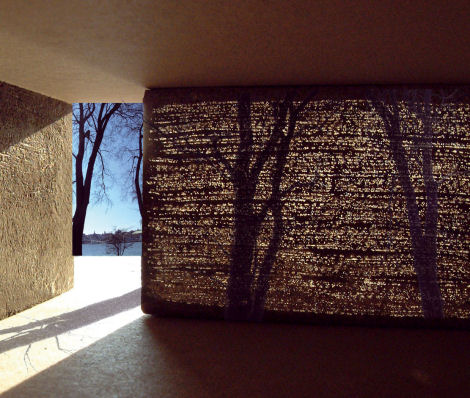Many of the control systems designed for use with sensory equipment (snoezelen equipment) seem to be very large cumbersome objects which are ot very aesthetically pleasing and often do not fit in with their environment. Whilst it is understandable that simple control systmes will be preferable for those with limited mobility, should they be as bulky and disconnected from the product they control?
Tuesday, 30 November 2010
Sound Reactive Lighting
Impressive array of lights and mirrors used within a nightclub environment reactive to the sound.
Whilst the effect is too intense for a sensory environment, a softer, smoother programme could be written with potential for the user to interact with the system possibly changing colour schemes and patterns.
Sigur Ros
Sigur Ros - Hoppipola
Sigur Ros, a group of musicians renowned for making some of the most calming and soothing music in recent times. Could be used within a sensory environment to add an audible soothing element to the environment, potential to have sound controlled lighting to create effects linked between music and lighting.
Rosehill School's Sensory Room
Rosehill Sensory Room
Interesting look into what is advertised as 'the best sensory room within the U.K.' used for teaching the schools autistic pupils.
'Lightracon'
'Transparent concrete'
Fibre optics within the concrete moulding allow light to pass from one side of the concrete to the other, Interesting opportunites making 'hybrid' materials.
Could be particularly interesting when used within a building, with people walking on either side of the wall making shadows and other effects.
Could be particularly interesting when used within a building, with people walking on either side of the wall making shadows and other effects.
This material could also be usefull in creating a temporary sensory room, combining fibre optics in a similar way in a more lightweight material forming panels which could form a partitioning wall allows for lights to be shon onto the rear face, creating a more diffused effect on the inside.
LazerPod Range
The laser pod range
A clever use of LED's and 'lasers' to create a series of cosmic cloud and star formations in a room.
The technology used within this product could be adapted to suit the needs of 'less able' user with the potential for control systems to be put in place allowing the user to control the colour, intensity and pattern of the lighting.
Potential for other modules to be added to the system for other stimulation, such as sound and tactile stimulation.
Source
Potential for other modules to be added to the system for other stimulation, such as sound and tactile stimulation.
Source
Monday, 29 November 2010
'The Sixth Sense'
My Coursemate Showed me this amazing video by Pranav Mistry, developing technology to make an extra element of interaction to everyday life. The use of colour recognition to allow the user to interact with nothing more than coloured attachments to the users fingers and gestures.
The possibilities of a system controlled by nothing more than a users hands are endless, especially for users with limited mobility.
Klexl Virtual Painter
Klexl Virtual Painter
Projector and Stylus system allowing children to 'paint' on the walls without marking the surface, the allowing the image to be saved and projected again at a later date or printed.
However... the projector system is positioned behind the user causing shadows on the surface their trying to 'paint' on, which could effect the user experience.
'World Mood Light'
'Mood lighting' using simple arduino system to search twitter and detect the 'mood of the world'
Interesting virtual interaction between arduino and twitter, potential for interaction between user and arduino sensors to create similar effects with LED's
RGB Cube
Use of LED's to produce a range of colours in a single product.
combination of multiple LED's makes interesting effects
Shows the potential of simple circuitry to create simple effects using LED's, taken out of the cube form and applied to different shapes etc could provide basic sensory stimulation.
Laser Harp
Closer Look at the Laser Harp
The concept of using a laser to control a sound shows the potential for the concept within a sensory system, if a similar concept was placed alongside of within something similar to a laser pod it would add a whole new dimention to the product. However the technology to produce this sort of instrument is relatively expensive and bulky. (Laser module, Oscillators etc)
Jean Michele Jarre
Jean Michel Jarre - Rendevous
Interesting use of lasers to control sound as part of an 'instrument' (laser harp)
The distance from the lasers source effects the pitch of the sound produced.
Total Immersion - Augmented Reality
'Augmented Reality'
The opportunities for intercation with everyday physical objects explored, potential to make everyday life within our surroundings far more interactive whilst making every day items such as newpapers more immersive for the user.
This kind of system could benefit sensory systems in that it could allow the user to control the system using other items. For example a user could introduce a ball to the system, the system recognises this and changes its light patterns to a circular pattern.
However this technology is only within its early stages and is likely to be relatively expensive as it uses a series of camera's, projectors and computers.
Saturday, 27 November 2010
Kaoss Pad 3 - Touchscreen Interaction
A closer look at the Kaoss Pad 3 and the way touch screen effects the user intercation.
Complex combination of touch screen, rotary potentiometers and linear potentiometers to create useful sampling systems for DJ's and musicians.
The interaction with this product is relatively complex for those who are not used to using sampling equipment etc. However, if broken down and used individually on a more basic level it could provide a whole range of interaction within a sensory system.
Complex combination of touch screen, rotary potentiometers and linear potentiometers to create useful sampling systems for DJ's and musicians.
The interaction with this product is relatively complex for those who are not used to using sampling equipment etc. However, if broken down and used individually on a more basic level it could provide a whole range of interaction within a sensory system.
Matt Bellamy - Kaoss Pad interaction
Matt Bellamy (MUSE) Kaoss Pad intro, Touchscreen interaction controlling sound.
Misa digital 'guitar'
Touch Screen Controlled guitar, Interesting interaction to control sound.
4 Wire resitive touch screens available to be used with simple electronic systems to control lights and sounds? Featuring x-y control.
4 Wire resitive touch screens available to be used with simple electronic systems to control lights and sounds? Featuring x-y control.
Friday, 26 November 2010
Introduction
This blog will document the digital research element of the creative interaction module, looking at Sensory rooms and their users as well as looking at the application of different lighting techniques and interaction methods.
The main purpose for this research is to inform a design project for a sensory system for use within a domestic environment by those with learning difficulties, those who have suffered brain injury and also to relax able bodied people.
The research which follows is in the order that it was discovered.
The main purpose for this research is to inform a design project for a sensory system for use within a domestic environment by those with learning difficulties, those who have suffered brain injury and also to relax able bodied people.
The research which follows is in the order that it was discovered.
Subscribe to:
Comments (Atom)





